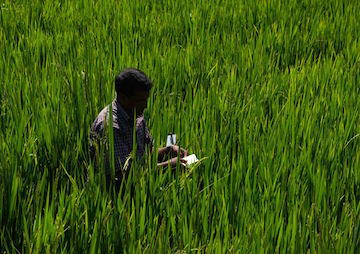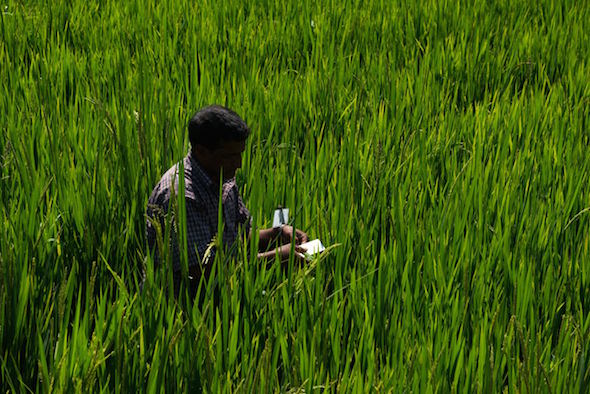Climate-Smart Villages Boost Nepali Farmers’ Harvests
Nepali farmers are finding that environmentally friendly cultivation methods increase yields -- and also help them adapt to rising temperatures and increasingly erratic rainfall.
By Kieran Cooke, Climate News Network

Climate-smart farming in action: Murali Paudel inspects his paddy in Dhaitar, Nepal. (By courtesy of Susan Hale Thomas / ICIMOD)
This Creative Commons-licensed piece first appeared at Climate News Network.
KATHMANDU — Murali Paudel wades into his rice paddy, carefully inspecting the soon-to-be-harvested crop.
By adopting what are called climate-smart cultivation methods Paudel, a farmer in the village of Dhaitar, about two hours’ drive into the hills north-east of Kathmandu, Nepal’s capital, says he’s increased his crop yield by at least 25%.
“We use dung mixed with cow’s urine and water to produce a fertiliser, and similar methods to produce a pesticide for rice and other crops like cabbages and potatoes,” says Paudel.
“Bigger harvests mean we can improve our incomes by selling more at market. The crops also seem better able to withstand rises in temperature and changes in rainfall.”
The livelihoods of more than 1.5 billion people are dependent on the region’s water systems.
Rapid warming
Scientists say temperatures across the Himalayas are rising at up to twice the global average. Rainfall patterns across the region — a vast and often inaccessible area stretching from the mountains of the Hindu Kush in Afghanistan in the west to the Tibetan plateau and China in the east — are also becoming increasingly unpredictable.
Farmers around Dhaitar and in other nearby villages say they have to adapt to changes in climate to ensure their incomes. Water availability is becoming a growing problem — with sudden intense downpours causing flash floods, and landslides interspersed with long dry periods. Villagers also say the monsoon, vital for the crops, is tending to arrive later each year.
In one village locals say that a decade ago they had 60 sources of water: now there are only a third that number.
Developing new farming practices, including rainwater harvesting and soil analysis techniques, are ways of tackling climate change. The Centre for Environmental and Agricultural Policy Research (CEAPRED), a Nepali NGO, has developed clusters of what are called climate-smart villages.
As well as helping farmers adopt new growing techniques, which include the use of polytunnels to grow cash crops such as tomatoes and cucumbers and cutting down on the use of chemical fertilisers, CEAPRED has also been encouraging the use of mobile phones to relay real time weather reports and information on crop diseases and infestations.
Chemical dependency
Working with the International Centre for Integrated Mountain Development (ICIMOD), a regional intergovernmental research organisation based in Kathmandu, CEAPRED hopes the climate-smart village concept will spread across the country.
The project is still very much at a pilot stage. The majority of Nepal’s farmers, particularly those in the southern plain areas, are still largely dependent on chemical fertilisers, the bulk imported.
Along with changes in climate Nepal — a country of more than 30 million people, where per capita income is a little over one US dollar a day — is having to cope with a number of other serious problems.
A series of earthquakes starting in April this year caused more than 9,000 deaths. A large quantity of precious livestock was lost, while hundreds of thousands of homes and large swathes of infrastructure were destroyed.
In recent weeks Nepal, which for a decade from the mid-1990s was embroiled in a bloody civil war, promulgated a new constitution. Nepalis of Indian descent who have settled in the south of the country say their rights have been abused.
Border problems
The border between India and landlocked Nepal has been blocked: farmers say they can’t get their produce to market because fuel imports have dried up. There are also worries about fertiliser imports: the harvest in Nepal could be severely reduced if the blockade is not lifted.
Many millions of Nepalis — the majority of them men — have migrated in search of work. With many of the men absent, women — who traditionally do much of the labouring work in the fields — play a key role in farming co-operatives and in overseeing the adoption of climate-smart farming methods.
Muna Shrestha is secretary of the local farmers’ group. “With better cultivation methods we have improved our production,” she says.
“But with the rice harvest coming, due to the damage of the earthquake we have nowhere to store our crops. Many people, particularly the children, still suffer psychological trauma because of the earthquake.
“Life is not easy for us — but for other villages, more remote and with more damage from the earthquake, it is much harder.”
Your support matters…Independent journalism is under threat and overshadowed by heavily funded mainstream media.
You can help level the playing field. Become a member.
Your tax-deductible contribution keeps us digging beneath the headlines to give you thought-provoking, investigative reporting and analysis that unearths what's really happening- without compromise.
Give today to support our courageous, independent journalists.








You need to be a supporter to comment.
There are currently no responses to this article.
Be the first to respond.